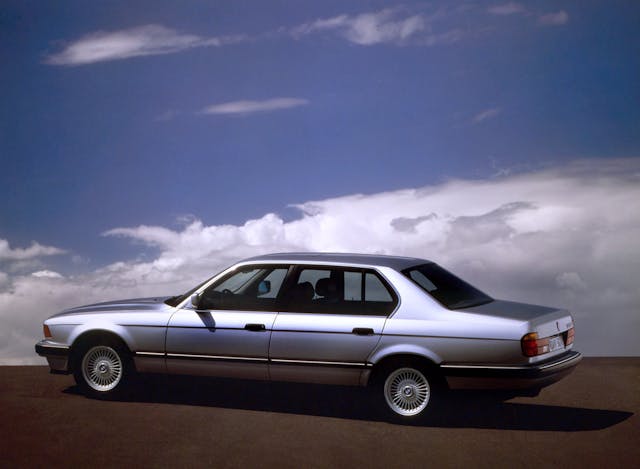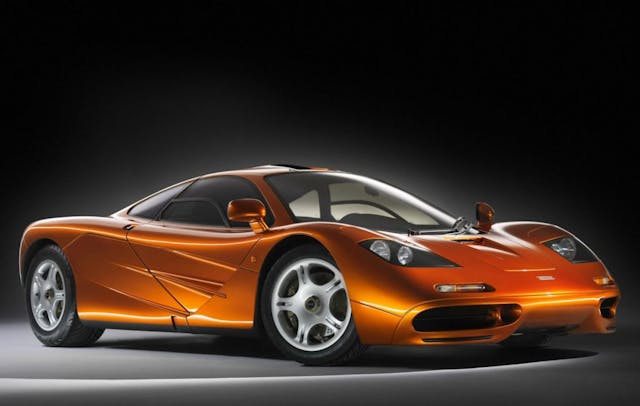These 7 legendary machines bore BMW’s epic V-12
BMW’s venerable V-12 is breathing its last. Bowing out in a twin-turbo 592-hp edition of the M760i super sedan, this final edition marks an end to 35 years of 12-cylinder BMWs. As we bid a fond farewell to this epic engine let’s take a look back at its most impressive incarnations and applications, including machines for the road, the race track, and even some for other automakers.
1987 BMW 750i

If you were a true Wolf of Wall Street in 1987 and wanted the ultimate driving machine to prove it, then BMW had the answer: the E32-generation 750i sedan, fitted with the company’s first production automotive V-12. At five liters in capacity its output was a modest-by-today’s-standards 295 hp. Essentially this M70 engine was two M20 inline-sixes joined together at the crank at a 60-degree angle, with single overhead camshafts.
That’s not to say it was unsophisticated, however. BMW made the engine block from Alusil, used fancy mass-air-flow sensors and fitted hydraulic valve-lifters, and a drive-by-wire throttle. The 750i was a technical tour-de-force that left rivals Mercedes-Benz scratching their heads. Opt for the stretched L version (why bother with anything less?) and you’d get such goodies as a trip computer, dual zone climate control, heated seats front and rear, a car phone, CD autochanger and headlight washers. You could even specify such luxurious extras as powered sun shields and a wine cooler. Which no self-respecting wolf would do without.
1992 BMW 850CSi

By 1992 BMW had been experimenting with a flagship M8 version of its 8 Series coupe. The idea was to surpass its own V-8- and V-12-powered models and rival Ferrari. Engineers increased the M70’s capacity to 5.6 liters (renaming it S70 in the process), raised its power output to 375 hp and installed a six-speed Getrag manual transmission. Instead of landing in an M8, a car that never happened, a version of the S70 known as the S70B56 would top the range in BMW’s limited-run 850CSi. That car could crack a six second 0-60 mph time, and along with the extra power came lowered suspension with stiffer springs and dampers, and a quicker steering ratio than regular 8 Series models. European models even came with rear-wheel steering. Just 1510 of these S70-powered cars were built, making it one of the rarest BMW engines ever made.
1992 McLaren F1

When Gordon Murray was looking for an engine to power the F1 supercar he first turned to McLaren’s Formula 1 partner Honda. It’s only thanks to the Japanese firm’s decision to decline that the greatest BMW V-12 engine came to be. Paul Rosche at BMW M developed an all-new aluminum and magnesium six-liter version of the S70, dubbed S70/2, with double overhead cams, four valves per cylinder, variable valve timing, and dry sump lubrication which took the V-12 to new heights. It produced an astonishing 618 hp at 7400 rpm without resorting to forced induction, surpassing Murray’s specification for power, while only being marginally heavier than he hoped. Supercar history was written.
1999 BMW V12 LMR

Having won Le Mans with the McLaren F1 GTR in 1995, BMW set its sights on a fully-branded victory at the French endurance race. Its first attempt in 1998 with a six-liter normally-aspirated V-12 derived from the McLaren unit resulted in retirement, but for 1999 BMW Motorsport joined forces with Formula 1 team Williams to develop the V12 LMR. Running at around 590 hp and driving through an XTrac six-speed sequential transmission, the S70/3 engine had the reliability and the pace to take the win.
1999 Rolls-Royce Silver Seraph

Having acquired Rolls-Royce in 1998, BMW was seeking a way to distance the brand from its long-term bedfellow, Bentley, which was now owned by VW. The first step was to install its own V-12 into a Roller. The uprated M73 5.4-liter unit which had made its debut in the 1994 750i and 850Ci was the deemed just the job for the first V-12 Rolls since the 1939 Phantom III. The increase in capacity gave the V-12 a suitably “sufficient” 322 hp and was mated to a wafty five-speed automatic. The Silver Seraph was relatively short-lived, with just 1570 models built by the time production ended in 2002.
2003 Rolls-Royce Phantom

BMW soon realized that if it was going to be charging Rolls-Royce prices it would need a bespoke motor. So, when the all-new Phantom came along, it was powered by a 6.75-liter version of the six-liter N73 V-12 developed for the 2003 7 Series. Now modernized with dual overhead cams and a double VANOS variable valve timing system with variable valve lift it offered 453 hp and exceptional smoothness, as suited for such an upmarket application.
2008 BMW 760i

2008 marked the debut of the current (and final) generation of the BMW V-12. It also introduced turbocharging to the twelve for the first time, enabling power outputs unseen since the days of the McLaren F1. At its launch in 2008 the engine, now known as N74, had a capacity of six liters and an output of 536 hp and was first installed in the BMW 760i. Rolls-Royce would employ a 6.6-liter with up to 624 hp in the Ghost, Wraith, and Dawn, with a 563 hp 6.75-liter version reserved for the Phantom. Rolls-Royce has pledged to keep the V-12 alive until 2030, but at BMW the 6.6-liter, 592-hp M760i will be the last of its kind.


